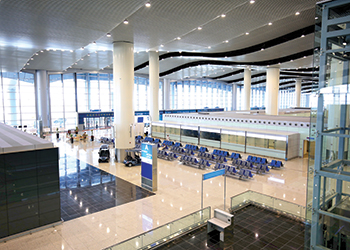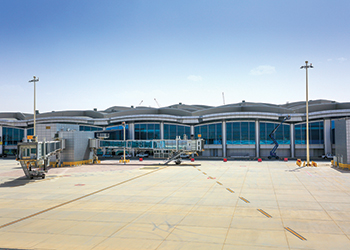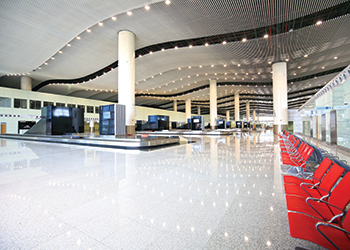Terminal Five opens up for flights in Riyadh
01 July 2016
A new terminal has become partially operational at Riyadh’s King Khalid International Airport, as part of a massive expansion being implemented over two phases at the gateway to the Saudi capital.
With its recent opening, Terminal Five becomes the kingdom’s first privately-run airport terminal.
Spread over 100,000 sq m, it includes eight double-gates that can accommodate 16 medium-size aircraft (C-type), seven E-type airplanes or an F-type airplane.
Terminal Five includes 60 check-in desks, 20 self-service machines, five baggage carousels, 30 elevators and 19 escalators, and nine travellators. The first and business class lounges cover an area of 2,138 sq m.
The terminal has a capacity to handle 12 million passengers per year and will be used to cater to domestic routes.
King Khalid International Airport, which opened in 1983, is one of the largest airports of the world and the second largest in Saudi Arabia with an area of 315 sq km. The airport handled 18.58 million passengers in 2013.
According to Tarek Abdul Jabbar, assistant to the president of the General Authority of Civil Aviation (GACA) for airports, Saudi Arabian Airlines and Flynas will operate domestic services from Terminal Five to five destinations – Sharoura, Al Wajh, Turaif, Al Qurayyat and Hofuf.
 |
Terminal Five... features 60 check-in desks and 20 self-service machines. |
Domestic services will be increased gradually to cover all other destinations in the kingdom, and all the domestic services being handled by Terminal Three will soon be transferred to Terminal Five.
The design and construct contract for the terminal was awarded by GACA to a joint venture of TAV Tepe Akfen of Turkey and Al Arrab Contracting Company. Saud Consult and Aecom were the consultants. The scope of work included a built-up area of 246,000 sq m consuming 93,000 sq m of concrete.
Elaborating on the contract, a GACA spokesman says: “The contract included a bridge and road network that connects the newly developed areas of the airport with the main road linking the airport with Riyadh. It also connects other terminals and facilities of the airport.”
The terminal will be connected with the upcoming Riyadh Metro.
Also included in the contract was an additional multi-storey car-park for 3,000 cars, a fire-fighting station, an apron operations building and a new apron gate.
Meanwhile, passengers will be able to access a shuttle bus service to other terminals every 10 minutes.
According to Arab News, Terminal Five will be operated by Dublin Airports Authority International (DAAI), a subsidiary of the Dublin Airport Authority, under an initial contract for five years. It was chosen from among five other aviation companies from Europe, Asia and Africa.
 |
An aero-bridge at the new terminal. |
The $400-million terminal forms part of expansion plans designed to boost the airport’s capacity from the existing 14 million passengers to 40 million by 2038.
King Khalid International Airport consists of four passenger terminals, only three of which are in use – terminals One, Two and Three. Each terminal has eight aero-bridges. Work is in progress on the redevelopment and expansion of Terminals Three and Four, which will increase their capacity to 17.5 million passengers a year. They will have 22 gates serving 44 medium-size aircraft.
Meanwhile, work is also under way on the executive office project at Terminal Five, as part of GACA’s plans to introduce these VIP facilities in 26 airports around the kingdom. The VIP lounges are available to the public for a fee and provide travellers with a high quality of service.
The VIP lounge at Terminal Five covers an area of 2,750 sq m and will have a capacity of 170 passengers. It comes with reception counters, a meeting room, a commercial area and a shuttle service to and from the aircraft by luxury cars.
Work is also under way to upgrade the executive office located in Terminal Two at the King Khalid International Airport.
Saudi Arabia has a pipeline of projects under way and planned in the aviation sector and is increasingly looking at public-private partnerships (PPP) to pursue its ambitions in this sector. It’s first PPP airport project opened at Madinah in July 2015 and was built by a consortium including Turkey’s TAV Construction, Al Rajhi Group and Saudi Oger.
According to Deloitte’s new GCC Powers of Construction report, several governments across the region are looking at alternative ways of funding airport development, including potential privatisations and PPP schemes.



